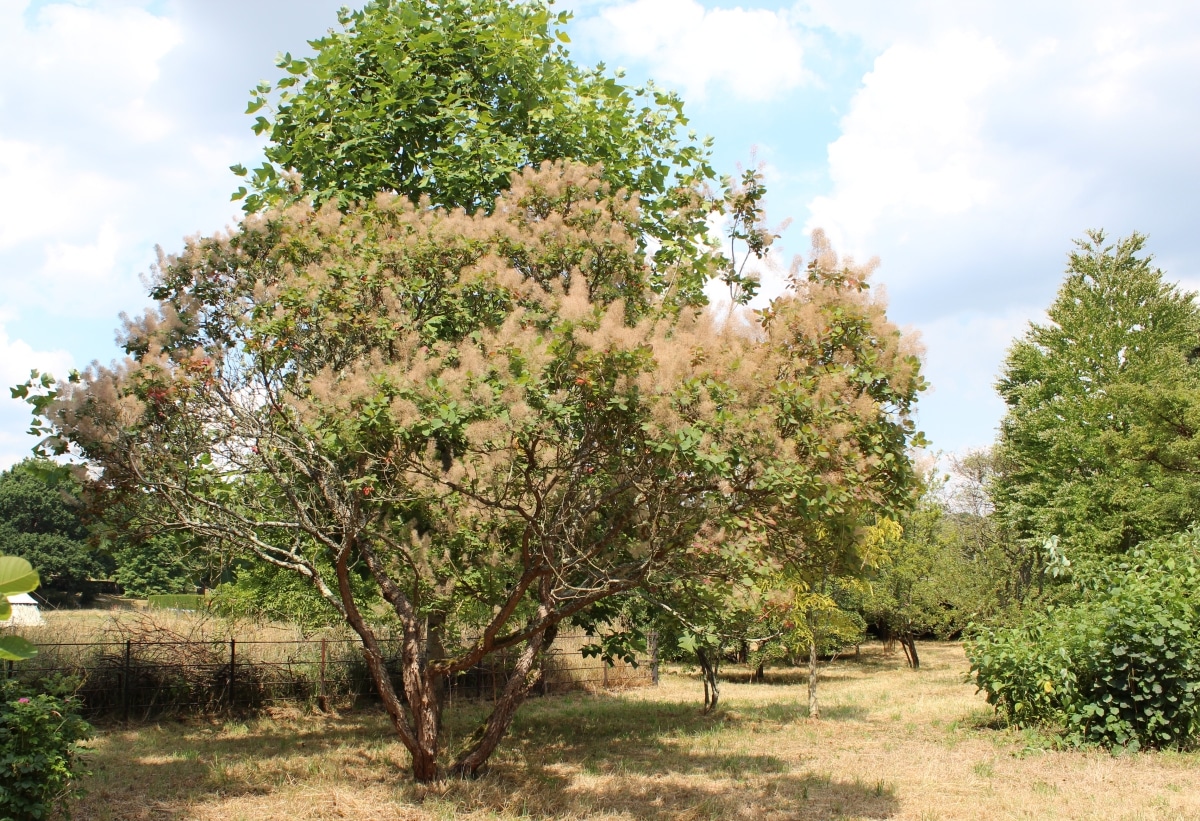
Image – Wikimedia/Joanna Boisse
El Cotinus coggygria it is a relatively small tree that produces curious flowers, so much so that it receives the name of the wig tree since the inflorescence resembles these. In addition, it is a plant that can be used to decorate the terrace as well as to create a low or medium hedge in the garden. It tolerates pruning quite well, which is why it is also an interesting species for fans and lovers of bonsai.
And as if that were not enough, we are talking about a tree that is well adapted to living in a variety of climates, from temperate to subtropical. It needs cool winters to know when to rest, so it would not be feasible to grow it in an area where temperatures remain high throughout the year.
Wig Tree Features

Image – Wikimedia/Uebermut57
Our protagonist it is a deciduous tree that reaches a height of 5 to 7 meters whose scientific name is Cotinus coggygria. It is native to southeastern Europe, although it is also found in Asia. Its leaves are oval, measure between 3 and 8 centimeters, and are green or reddish, depending on the variety. In autumn they become yellowish or scarlet.
Blooms in spring, producing yellow flowers that are grouped in an inflorescence up to 30 centimeters long. And its fruits are drupes of about 2 millimeters that mature throughout the summer.
What uses is it given?
Al Cotinus coggygria it is only given one use, the ornamental. It is planted in gardens, grown in pots and can even be used as a bonsai. In addition, it is possible to have it as a bush or as a small tree, since it is a plant that recovers well from pruning as long as it is done at the end of winter and with previously disinfected tools.
How do you take care of the Cotinus coggygria?
It is a plant that is very easy to care for. It does not require any special attention, although it is recommended that you take into account the advice that we are going to offer you below:
Location
It must be outdoors, either in the garden or in a pot, and it is also important that it gets the sun, at least a few hours a day, otherwise it will not be able to develop normally and will end up weakening.
Its roots are not invasive, so if you want to plant it in the ground, you can put it near other plants or even soils with soft paving.
Earth

Image - Wikimedia / 阿 橋 HQ
- Garden: it is a plant that grows in soils with organic matter, and well drained.
- Flower pot: if you want to have it in one, you can fill it with universal crop soil, like the one from the brands BioBizz o Flower. Another option is to make the following mixture yourself: 60% peat + 30% perlite + 10 earthworm humus.
Irrigation
Irrigation it has to be moderate. This means that if, for example, the climate is very hot and dry, taking into account that the soil is going to lose moisture quickly and that the tree will be growing, it will be necessary to try to water two, three or four times a week, depending on the weather. how long it takes for the earth to dry up.
On the contrary, during the cooler or colder months, it will have to be done less frequently, since if we continued to water 3 or 4 times a week in winter, we would surely rot the roots. In fact, in that season, it may not be necessary to water it, or it may have to be done very little depending on the climate of the area, and if it rains it will not be necessary to hydrate it.
Subscriber
The wig tree can be fertilized during the growing season, that is, in spring and summer. Likewise, it is possible to continue doing it until autumn if the temperatures in that season are mild and there are no frosts yet. For this, fertilizers of natural and/or ecological origin will be used, such as guano, manure or earthworm humus. If you have it in a pot, it is highly advisable to use fertilizers or liquid fertilizers so that the roots can absorb nutrients more quickly.
Multiplication
El Cotinus coggygria It is a tree or little tree that multiplies from seed in pots with seedling soil, and semi-woody cuttings in spring. In fact, you can take advantage of some pruning remains to get new specimens. Impregnate the base with rooting hormones (like these from here) and then planting them in containers with drainage holes with, for example, vermiculite or coconut fiber (for sale here). In a couple of weeks, if all goes well, they will start to root.
Pruning
Pruning it will be done at the end of winter or at the beginning of spring if it is a young specimen that has not yet flowered, otherwise it is recommended to wait until the flowers wither. When the time comes, the branches that are broken and dry will be removed, and if you want, if necessary, those that are sprouting from the lower half of the trunk will be removed to give it the shape of a tree.
Rusticity
It withstands frost and snowfall very well, being able to withstand temperatures of up to -18ºC smoothly.

Image - Wikimedia / David J. Stang
What did you think of the wig tree? Did you know him?